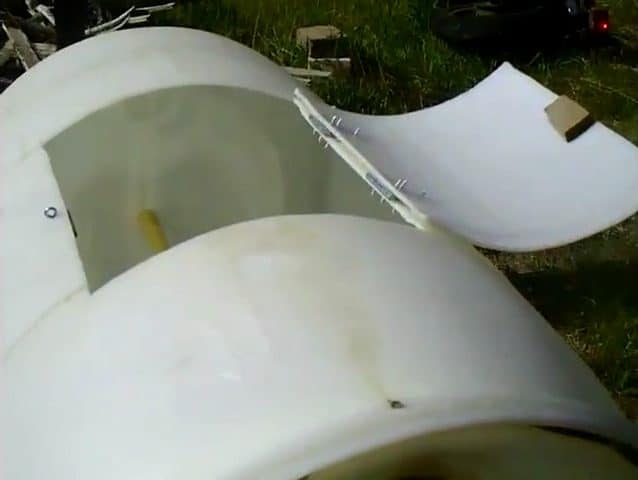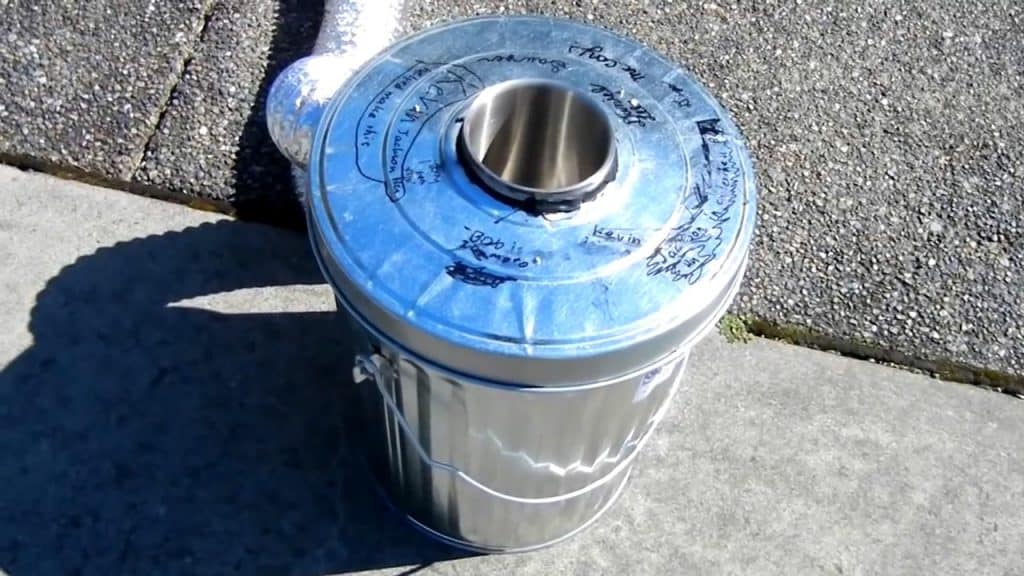
Are you living off the grid and seeking a sustainable solution to washing clothes without the need for electricity? This project provides a comprehensive guide on how to construct an off-grid washing machine and compost tumbler from an old 55-gallon plastic drum.
With detailed step-by-step instructions, this guide offers a practical and cost-effective solution for off-grid living enthusiasts seeking to live sustainably.
The hand-crank mechanism and composting feature make it an eco-friendly option for washing clothes and composting organic waste material.

STEP 1 : THE BARREL SUPPORT
To create a sturdy framework that can hold up the 55-gallon plastic drum for the washing machine and compost tumbler, the project requires several key components.
The framework has uprights on the edges that run all the way down to support the barrel. These uprights are made from 3-foot long 2 x 4s, which are attached to a base that is also made of 3-foot long 2 x 4s.
To hold the two sides of the framework together, a long brace that is three feet eight inches long is added. This brace provides extra support and stability to the framework, ensuring that the barrel remains secure during the washing and composting process.
One of the advantages of this framework design is that it can be taken apart easily by unscrewing the side rails. This allows you to store the barrel and framework separately, making it ideal for an off-the-grid situation where storage space may be limited.

To ensure that the barrel remains stable on the framework, it is necessary to install a one-inch hardwood dowel through the one-inch hole located at the top of the upright.
This dowel provides a sturdy base for the barrel to rest on, preventing it from wobbling or shifting during use.
When installing the dowel, it’s important to take note of the line that runs through the middle of the barrel. This line serves as a guide for finding the center of the barrel, which makes it easier to position the dowel correctly.
To locate the center, simply measure across the line and divide it in half.

STEP 2 : THE HAND CRANK
The hand crank is a crucial component of the off-grid washing machine and compost tumbler. It is made using PVC pipe, which is durable and easy to work with.
To attach the hand crank to the barrel, screws are inserted into the end side of the barrel, providing a sturdy base for the crank.
One of the key advantages of the hand crank is that it provides you with something to grab onto when the washing machine or compost tumbler gets heavy.
This allows you to pull it back up and move it around easily, even when dealing with large loads of laundry or compost.

STEP 3 : THE DOOR
To make the washing machine and compost tumbler more user-friendly, a door is added to the front. This door measures one foot by one foot, providing ample space for unloading clothes or compost.
To hold the door in place when it is opened, a couple of cheap cabinet hinges are used. These hinges are easy to install and provide a reliable way to keep the door in place.
To ensure that the door remains securely closed when not in use, a little S hook latch is added. This latch is easy to operate and can be locked into place, providing additional security and preventing the door from opening accidentally.

STEP 4 : THE DRIANAGE
To ensure that the washing machine and compost tumbler are easy to clean and maintain, a drainage hole is added in the middle of the barrel.
This hole allows you to drain the water or compost tea from the barrel easily and efficiently.
To make the drainage hole more effective, a small plug and cap are added. These components act as a drain, allowing you to easily remove the water or compost tea from the barrel.
The plug is inserted through the hole from the inside, and then sealed with PVC glue to prevent leaks.
Having a drainage system in place makes the washing machine and compost tumbler more user-friendly and efficient. It allows you to easily remove the water or compost tea from the barrel, preventing the buildup of excess moisture and bacteria.

STEP 5 : THE PVC PIPE AGITATORS
To make the off-grid washing machine more effective at cleaning clothes, agitators are added to the barrel.
These agitators are designed to help move the clothes around, allowing them to roll over the agitators back and forth, which helps to remove dirt and grime more effectively.
To create the agitators, three PVC pipes are added inside the barrel. These pipes are positioned strategically to ensure that the clothes move around effectively during the washing process.
The PVC pipes are easy to install and can be adjusted as needed to ensure that they are positioned correctly.
By adding agitators to the barrel, you’ll be able to create a more efficient and effective washing machine. The agitators help to move the clothes around, ensuring that they are cleaned thoroughly and effectively.

STEP 6 : THE WORKING
To use the washing machine, start by loading clothes into the drum through the top opening. Add enough water to cover the clothes, followed by a biodegradable liquid detergent.
Then, close the lid and begin moving the hand crank back and forth to agitate the clothes.
The agitators inside the drum help to slosh the clothes around and get them grinding against each other, removing dirt and grime effectively.
After approximately 15 minutes of agitation, pull the drainage plug off the bottom of the drum and drain the water.
You can either recycle the water by collecting it in a bucket and using it to water your plants and trees, or simply drain it away.
Once the water is drained, put the plug back on and refill the drum with clean water for the rinse cycle. Agitate the clothes for another 15 minutes to ensure all detergent is removed.
Once again, pull the drainage plug and collect or drain the water. It’s important to use biodegradable soap or detergent when washing clothes in this off-grid system, as the soapy water may be used to water plants and trees.

We put the plug back on, fill the barrel with some clean water and agitate for another 15 minutes. This is the rinse cycle. Pull the plug, drain that water or use it on your plants.
STEP 7 : DOUBLES AS A COMPOSTER
In addition to being a hand-crank washing machine, this setup can also be repurposed as a tumbling composter.
Compost is an essential ingredient for a healthy garden and can be made from various waste materials such as leaves, grass clippings, kitchen scraps, and even animal manure.
To turn the barrel into a composter, simply add these materials to the drum and turn it every couple of days using the hand crank.
It is important to keep the compost aerated, as this allows the microbes and bacteria to break down the materials more efficiently, promoting decomposition.
After a period of about 2 to 3 weeks, the compost should be ready for use in your garden. Through the drainage hole, you can also collect the nutrient-rich residue of compost tea, which is an excellent fertilizer for plants that require high amounts of nitrogen.
This setup not only provides a sustainable way to clean your clothes off-grid but also helps you turn waste materials into a valuable resource for your garden.
























